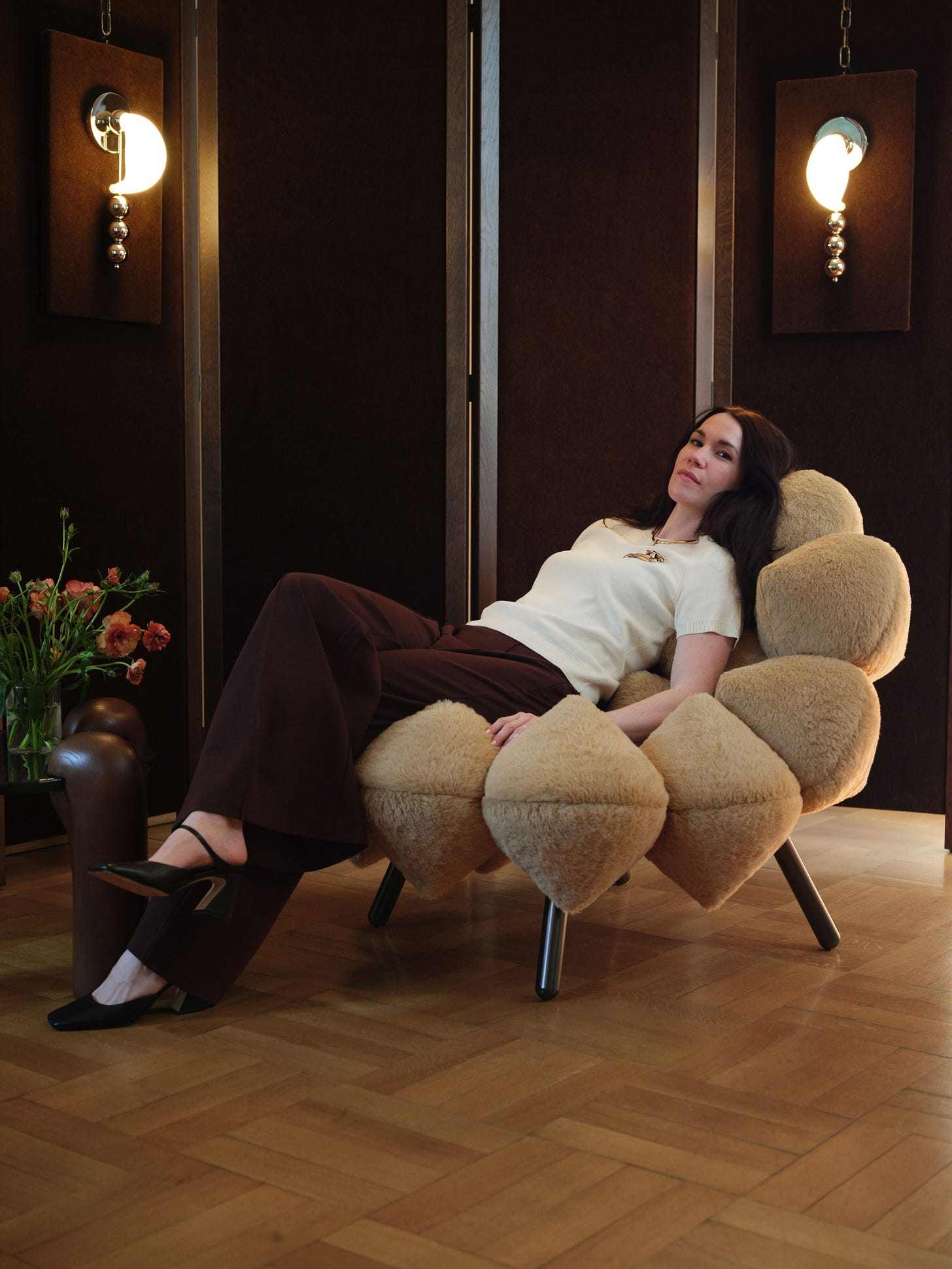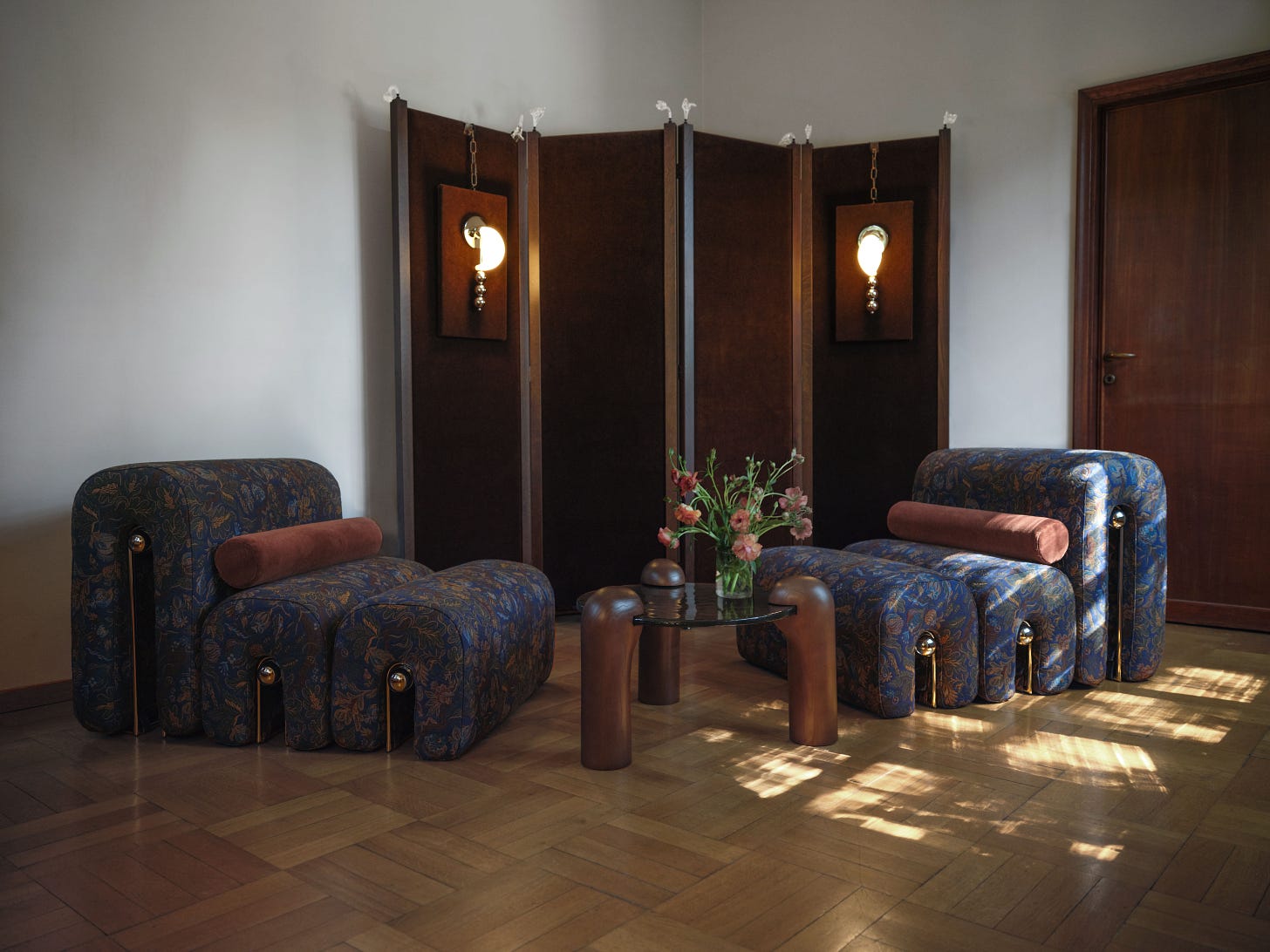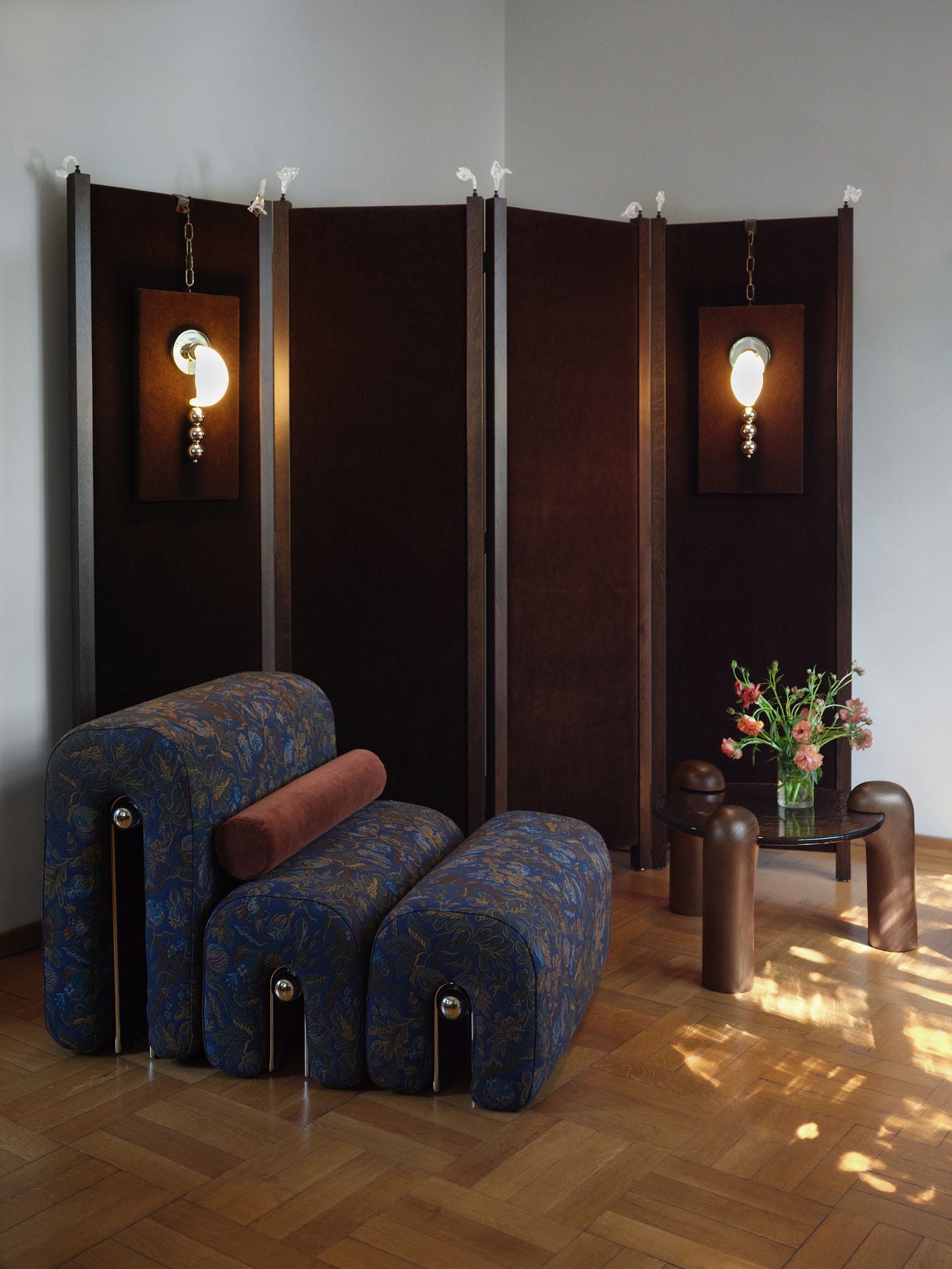Examining the quiet luxury of Soft Witness
Whitney Krieger on finding inspiration in unexpected places and why design is better with dialogue

It was a series of serendipitous moments that prompted Whitney Krieger to trust her intuition and start building the foundation for Soft Witness. After moving from San Francisco to Florence to get a master’s degree in 2020, she quickly became embedded within the city’s close-knit community of artisans and creatives, and her own design practice began to take shape. “There’s nothing that compares to the feeling of seeing a sketch on a paper be realized into a real piece that you can interact with and touch,” Whitney says. “I just thought, ‘Wait, I’ve done this for so many other people for so long, and now I’m taking this leap to do it for myself.’”
If the name Soft Witness looks familiar, you might recall seeing it appear in my design trend predictions for 2024 under the section about furniture with bolster and foam roller-esque features—the Liberamente daybed still lives in my head rent free. At the time, Whitney told me that the bolster component was “a juxtaposition that hits just right, which I think is something we’re all craving right now—things that feel good together, despite their differences.” She also pointed out that it offers “the perfect elbow perch when lounging with a drink in hand or a comfortable pillow for propping your head up,” which is exactly how I want all of my furniture to function.
Last month, the creative director and interior designer presented “In Repose” at Villa Borsani for ALCOVA—an exhibition she’s bringing to VERSO & Friends at Nine Chapel in Brooklyn, NY. This week, her Tienilo table is also featured in “The Family Show,” a group exhibition on view at Love House’s new showroom on 179 E Broadway through May 30. Ahead of all the incoming NYCxDESIGN chaos, I spoke with Whitney from her historic home in Columbus, Ohio (she lives there part-time between Chicago and Florence) about investing in your own creative development, preserving life through objects, and the thrill of solving design dilemmas. I couldn’t have dreamed up a better person to debut Watch This Space, a new franchise spotlighting design stars on the rise.
Before we get into everything, what was that process of house hunting like for you?
Whitney Krieger: It really happened so fast, I thought “Maybe instead of renting, I should try to buy something.” I saw a few homes and then this one [in German Village] came up. It was built in the 1880s and it had all the character I would want, but I didn’t even think I would do anything to it. I thought I would just move in and live with certain things; I bought it and within a couple weeks I ended up hiring a contractor. It’s interesting because I’m starting to spend more and more time in Chicago and New York, and it almost feels like this is my second home as opposed to where I live. I get to come here and it’s a little retreat, you know? It’s taken on different things for me at different moments. I’ve only been here a year, so we’ll see what’s next.
Can you recall your earliest design memory?
WK: I’m going back to early childhood, this is such a random story. I grew up in a small town in Michigan on the lake, and my dad and my grandpa were both really handy kind of able to do everything people. My dad has single handedly fixed and restored a lot of the homes he’s lived in, and my summer jobs often were helping him paint, strip wood doors, or whatever random construction work. My grandfather had this workshop in his basement and I think I had to be like eight, I was so young, and I wanted to make a podium for my dolls so that they could be a teacher. He had taught me how to use a hammer, a nail, and a saw, and how to put something on a clamp on a table. There was no machinery that you turn on, everything was by hand. I made a teacher’s podium for my doll and I just remember so vividly deciding how to do it and what angle the top should be at. It’s wild how quick and natural and fun that was for me.
Given that you have some of these foundational memories from early on, was there a definitive moment where you realized you wanted to pursue a career in design?
WK: It was pretty intentional and also organic. I’ve always considered myself more of a jack of all trades than a master of anything because I love so many subjects. I’m all over the board and my interests—I remember looking ahead to college in high school and trying to figure out my major, and I was really interested in studying psychology, but I didn’t really know what I would do with it. It felt like more of a study that I wanted because I had an interest in psychology, not necessarily because I wanted to make a career out of it, and then the other things I wanted to do were pretty much all art related.
I grew up watching a very hard working mom and hard working dad build careers for themselves, and they always greatly supported my creativity and celebrated that, but I definitely had the starving artist narrative in my head that it was not a good choice. As much as I value the artistic side of myself, I’m highly pragmatic and logical. It sort of occurred to me, between working for my dad in the summers, doing art, and then seeing this applicable way you could make a career out of doing something creative but have a salary from something reliable that really appealed to me. So it sort of went forward like, “How can I build a career that can be a true career where I can support myself, but get to be an artist?” The sense of home has always meant so much to me so it was very easy, it was a no-brainer. I don’t know that I ever decided, it just sort of made sense.

I feel very similarly with writing; I always enjoyed doing it as a child, but had to figure out which route to go when I got older. Journalism was honestly an accident, I never aspired to be a reporter, but I didn’t want to become an English teacher. You’re having to make this big life decision at 18, I was like, “Well, this seems like the thing where I can probably have a stable income…” Now, of course, the joke’s on me, but at the time it made sense!
WK: Frankly, in the same sense of that, I worked for firms for the first 10 years of my career, and I did have something reliable, but you can only go so far with that. Ultimately, it’s the principle of the company. You have to take bigger risks to really move forward, so that’s what I’ve done with [Soft Witness] and it’s great, but it’s still a huge leap of faith. Like one year might be a great year, but as you know, the design community is super fluid and trendy and you got to keep up. That very much is sort of the joke’s on me like, “Well, I wanted something stable, so I started a furniture line and will figure it out as it goes.”
In your own words, how would you describe your design style or aesthetic?
WK: I both love and loathe this question, and it’ll become clear why. I have this really deep argument with myself about being put in a box, I just hate it. When you’re in the design world it’s a little easier because people understand design, so when you try to categorize yourself or explain your aesthetic you can reference things that are more niche. But when the average person who doesn’t know design is like, “So what’s your style?” I don’t know to respond because to me, I’m everything. What I’ve outputted I’m super proud of and I feel like is only 5% of my aesthetic range and interest. It was really hard to pick what to debut in that first collection and it’s one reason I came out with guns a blazing showing such different things and such a range.
I really purposely wanted to put out the seating, the lighting, the table collection, and the small sculpture to show, “Hey, I’m not going to be just a lighting company. I’m not just going to do furniture or upholstered goods.” I think they all live together harmoniously, they’re very much from me, but I tend to think of things as an interior designer on almost a project basis where things should feel like they want to live together, but they’re not like a perfect matching set, or they don’t have to necessarily make sense together. In fact, sometimes contrast and juxtaposition is a breath of fresh air.
I’m really cognizant of the fact that [Liberamente] could be perceived as this bubbly, chunky piece—and it certainly is—but the the inspiration from it is actually a neoclassical molding on a building that felt like it needed to be played with, and I extruded the shape and ended up with the frame. And then the cushions were a happy accident of how you put cushions on top of this frame idea. It’s for sure my most mass manufacturable piece and that’s sort of by design, it’s meant to be this piece that can be made really special. It was so fun in Milan a month ago to show it in a pattern that lended itself to feeling more romantic because that piece wants to be that to me in some ways, but it could also be extremely utilitarian if you wanted it to be.
I love the Joan side table, it makes me think of a little creature.
WK: I have sketches of that table before it became what it is and it was even more creature like, I think I sort of toned it down. [laughs] There is something I’m drawn to about anthropocentrism or personification of pieces. I mean, it’s the reason for the name Soft Witness. It’s not meant to be a literal “everything’s alive” witchy thing, it’s more like we live with these objects that end up meaning so much to us, and so inherently we sort of assign a bit of a soul to them. When you inherit something from a family member, pick up a book in a vintage bookstore, or buy some random vessel you found in a flea market, there’s a reason we’re drawn to them; they have lived these lives before us. If my pieces could end up being that for anyone, that’s the ultimate goal… As humans, we take ourselves way too seriously. At the end of the day, I just want to have fun. I want to put out work that brings people joy in the most basic way, and it being a functional object is the cherry on top. That’s what it should be, not everything has to fit some perfect rule book.

You recently debuted a new collection during Milan Design Week. Could you tell me more about the pieces that were part of the In Repose exhibition?
WK: So, “in repose” as the title, I could apply that to so many more things because I think it says a lot about how I think and work as a designer. As I’ve mentioned, the meaning behind objects and that being a piece for me, there’s always personal stories that I subconsciously end up pushing into my pieces. Some of them are a little more somber—I lost my mother a number of years ago, and she’s who the lighting collection is named after, the Patty scone. Instead of it being this sad homage, it brings me back to my interest in psychology and makes me want to be reflective and let things naturally exist in the world as they are and be okay with that, and let that be a part of the story.
It’s so interesting being an interior designer and always designing for a space and constraints and a client. It’s nice to have limits because it forces you to get creative and problem solve whereas when you design a collection that doesn’t yet have a home or an end user, of course you’re trying to be strategic to some degree about what people want to purchase because you have to be. But there’s no real limit around it and it can sometimes feel too ambiguous to run at. In this space, it was nice to be forced to solve a problem again as opposed to just show work that I designed that could go anywhere.
I heard that the shape of the Cono chair was inspired by a romanesco cauliflower…
WK: Yeah, so that one came out of a silly nature prompt—it was actually designed in school—to find some patterns in nature. I was living in Florence and I remember going across the street to one of the groceries and they had such different produce. In Italy, they sell based on the seasons so you don’t just go in and find a massive amount of things always available, especially when it’s a smaller store. They had all these green romanesco cauliflowers which you don’t find everywhere in the States. I thought the shape was so wild, it’s made up of all these cones and they kind of spiral. I was just marveling at the power of nature to create this extremely complex structure, it’s like a little art form in itself. I don’t know, it just made me want to design a crazy spiky cone chair, so here we are.
Are you working on any other exciting projects?
WK: I am trying to get around to doing a photo shoot of my house. I’ve only ever really presented my individual work as the line of goods, but to the core of myself I’m an interior designer so it will be fun to start to show people that side of myself a little bit more from an individual standpoint as opposed to the work I’ve done with other great firms. I do have a few tiny projects I do on the side, and haven’t really mentioned yet, so we’ll see about that. For my line, I have quite a few lighting things that are in the works; I am excited to do more with that. I have one collection I’ve been prototyping since I started the Patty series and I just haven’t perfected it yet so I’m hoping I can put more time back into that and get that moving in the year ahead.
Frankly, what I’d love to be doing—and I’ve started some conversations I’m really excited about—are some collaborations. As an individual designer, sometimes you can get a bit siloed and sort of spin on yourself, and I really believe deeply that design is better with dialogue. I really value the feedback and support my community has given me in that context. The idea of collaborating with other designers and artists that I admire is really exciting to me because you’ll both create something together that you couldn’t alone and that’s so fun. I’m definitely open to people reaching out about that and I have a few conversations in the works.






Thank you Sydney!! What an incredible interviewer and writer you are - feeling so seen. 🤍
Such a beautiful article… and a beautiful subject!!!